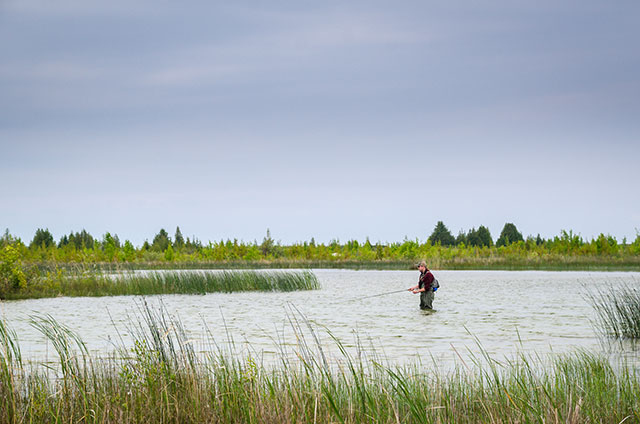The Heron’s Notebook

“Be the heron. Take the shot.”
July in mid-Michigan is hot. Humid sticky hot. Trout gasp in the deepest undercuts and conservation-minded anglers leave them alone. Beets and other sugary crops are pressed out of the land and the air is thick with sweet and heavy agricultural smells. The fields are dusty and flat, and do not resemble at all the greatest freshwater wetland on the continent, which they would still be if it not tiled and drained.
But just past the fields is the shore of Lake Huron and in some places there remains a thin strip of marshy, muddy estuary, alive with every conceivable freshwater shorebird and beast. Most impressive are the great blue herons, steely and deadly in their stalkings, perfectly designed for hunting the baitfish and gamefish of all types that teem in the nursery wetland shallows.
The enterprising trout angler would do well to spend some time among the herons, with a seven weight and a sunshirt. For midsummer is also when thousands of Huron’s giant bluewater carp swarm into these inlets and bays to spawn. They circle muddy the bays and breach like armored whales and are mostly preoccupied with procreation. But an angler should be thinking: they have to eat.
And they do, and will eat a fly. But it will not be easy to get them to do it. In addition to technical precision and artful presentation, the angler must possess or learn a powerful, observation-based predatory skill set. It is one thing to read the current and cast a fly to a rising trout. It is another thing—not necessarily harder, but very different—to spot a cruising carp, read its behavior, and feed it a fly.
Luckily for us, sight fishing tends to awaken some prehistoric predatory region of the brain. An inner heron. To succeed on the carp flats, the angler must find and nurture it.
I spent one memorable bachelor summer wading and paddling the windblown Great Lakes flats on both sides of Michigan. I did not become a master carp angler or even an average one, although I fished with and learned from some of each. I think I landed fewer than ten fish. But the learning was intense. These are some of those lessons.
Too bright, clear, and calm is just as bad as overcast, muddy, and windy. If you can see them, they can see you.
Note the sun and wind direction when planning a stalk. You can see through one side of each “wave” but not the other due to glare. At the 45th parallel in mid-July, an east wind is better in the morning, and a west wind is better in the afternoon
Groups of cruising fish are a waste of time. They will not eat. Single cruisers, on the other hand, are prime targets.
If there are lots of cruising fish, don’t chase them. Find a favorable casting position and let them come to you.
Assess the mood of the fish before you cast. Positive/Neutral/Negative?
Recognize the positive fish. The players. Gills and mouth working. Looking around, not moving in a straight line. When you can identify these fish, they are yours to waste.
Large groups of neutral and negative fish—especially spawners—can be major time sinks during limited favorable-light hours. They will not always flee from you and will often even chase flies. But if you are not getting eats, move on. It is hard to do.
Positive and neutral fish will become negative if they are spooked—if you cast over them, strip the fly too quickly in front of them, touch them with the line, cast an errant shadow, etc. They might not flee, but they will never, ever, eat. Move on.
Recognize the eat. Watch for leader or line or tail-tip twitch. Place your fly slightly to the side so he has to turn his head to eat it. In muddy water or at long range, you have to sense it some other way. Your eyes can deceive you. Stretch out with your feelings.
Fly design is 10% color, 20% size, 70% sink rate, and 10% confidence. Eschew the San Juan Worm at your peril.
With all these things in mind, I still blow most of the chances I get. But statistically so do most predators. Even herons. And each blown shot teaches a lesson, if we are open to learning it.
In these ways fly fishing for carp is like hunting. You are not casting to a riseform or to a likely-looking holding lie—not “angling”—but casting to a specific targeted fish. It is personal and vulnerable. You are looking your quarry in his face, reading his mood, reading the wind, and deciding whether or not to take the shot.
Be the heron. Take the shot.











